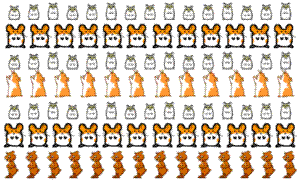Title:
The Hampster Dance

Meme Creator:
Deidre LaCarte
Media Creator:
Deidre LaCarte
Meme Creation Year:
1997
Media Year:
1997
Height of Popularity:
1999
Era:
Early Internet
Platform:
GeoCities
Animated Meme
Type:
Tags:
Animation, Viral, Early Internet
History:
The Hampster Dance stands as one of the earliest examples of an internet meme, created by Canadian art student Deidre LaCarte in 1997 (Wikipedia, 2025). LaCarte developed the original GeoCities website as part of a friendly competition with her sister and best friend to determine who could generate the most web traffic (CBC Arts, 2018; Wikipedia, 2025). The site featured rows of animated GIFs depicting hamsters and other rodents dancing in various ways, set to a sped-up sample from "Whistle-Stop," a song written and performed by Roger Miller for Disney's 1973 film Robin Hood (Wikipedia, 2025; Know Your Meme, 2009).
Initially, the website attracted minimal attention, recording approximately 800 total visits from its creation in August 1997 through January 1999 (Wikipedia, 2025). However, the site experienced explosive growth in early 1999 through email sharing and early blog promotion. By March 1999, traffic surged dramatically, with the site receiving approximately 60,000 views within four days (Throwbacks, 2017). This momentum continued throughout 1999, ultimately achieving over 17 million views by June of that year (Throwbacks, 2017).
The meme's widespread popularity generated various commercial adaptations and ventures. In 2000, LaCarte collaborated with Canadian remix duo the Boomtang Boys to produce "The Hampsterdance Song," which was released as a single in June 2000 (Wikipedia - The Hampsterdance Song, 2025; PetShun, 2025). The song achieved significant commercial success, reaching number one on the Canadian Singles Chart and peaking at number five on the Australian ARIA Singles Chart (Fluffy Tamer, 2024). The collaboration also resulted in the album Hampsterdance: The Album, released in October 2000, which reached gold certification in Australia (Wikipedia - Hampsterdance: The Album, 2025).
Despite its groundbreaking success, the original Hampster Dance website eventually became inactive. Nevertheless, its legacy endures as a pioneering example of viral internet content and foundational meme culture, predating many modern viral phenomena by demonstrating the potential for simple, user-generated content to achieve global reach (CBC Arts, 2018).
Notes about the Creator/s:
Creator (Media):
Deidre LaCarte is a Canadian art student who created the original Hampster Dance website and animated GIF content in 1997 (Wikipedia, 2025; CBC Arts, 2018). As the media creator, she designed and assembled the animated hamster graphics, selected the musical sample from Roger Miller's "Whistle-Stop," and constructed the overall visual presentation that would become the foundational media for the viral phenomenon. LaCarte developed the site as part of a web traffic competition with her sister and friend, initially focusing on creating engaging visual content rather than anticipating its cultural impact (CBC Arts, 2018).
Creator (Meme):
Deidre LaCarte is also credited as the meme creator, having developed the concept, design, and implementation of the Hampster Dance website that sparked the viral phenomenon. Her creation became one of the first viral internet memes, demonstrating the potential of user-generated content in the digital age and establishing foundational principles for viral web phenomena (Wikipedia, 2025; CBC Arts, 2018). Following the site's unexpected viral success, she became involved in commercial adaptations, including partnerships with music producers to create official songs based on her original meme concept (Wikipedia - The Hampsterdance Song, 2025).
Notes about the years:
Media Creation Year (1997):
The Hampster Dance website was created by Deidre LaCarte in August 1997 as part of a web traffic generation competition with her sister and friend (Wikipedia, 2025). The site was hosted on GeoCities and featured animated hamster GIFs set to a sped-up sample of Roger Miller's "Whistle-Stop" from Disney's Robin Hood.
Meme Creation Year (1997):
While created in 1997, the meme began its initial circulation through email sharing and early blog promotion during this period, though widespread viral distribution occurred later (Know Your Meme, 2009; Wikipedia, 2025).
Height of Popularity (1999):
The Hampster Dance achieved its peak viral status in 1999, experiencing exponential traffic growth from 800 total visits through January 1999 to over 17 million views by June 1999 (Wikipedia, 2025; Throwbacks, 2017). This period marked the transition from obscure website to global internet phenomenon, establishing it as one of the first major viral memes.
Sources and additional information:
CBC Arts. (2018, December 27). The oral history of the Hampsterdance: The twisted true story of one of the world's first memes. CBC Arts. https://www.cbc.ca/arts/the-oral-history-of-the-hampsterdance-the-twisted-true-story-of-one-of-the-world-s-first-memes-1.4958325
Fluffy Tamer. (2024, February 24). Uncover the Origins of the Iconic Hamster Dance Song: The Journey of a Viral Phenomenon. Fluffy Tamer. https://fluffytamer.com/hamster-dance-song-origin/
Hampster Dance. (2025, April 2). In Wikipedia. https://en.wikipedia.org/wiki/Hampster_Dance
Hampsterdance: The Album. (2025, April 9). In Wikipedia. https://en.wikipedia.org/wiki/Hampsterdance:_The_Album
Know Your Meme. (2009, March 15). Hampster Dance. Know Your Meme. https://knowyourmeme.com/memes/hampster-dance
PetShun. (2025, April 9). Hamster Dance: The Energetic Rodent Dance Craze Explained. PetShun. https://petshun.com/article/what-is-the-hamster-dance
The Hampsterdance Song. (2025, April 9). In Wikipedia. https://en.wikipedia.org/wiki/The_Hampsterdance_Song
Throwbacks. (2017, November 14). How The Hampsterdance Took Over The Internet, And Then The World. Throwbacks. https://www.throwbacks.com/story-behind-the-hampsterdance/